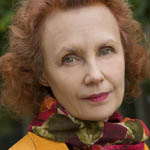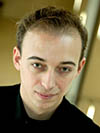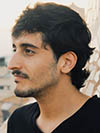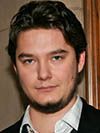Toru Takemitsu Composition Award
4 Finalists selected for Toru Takemitsu Composition Award 2015
[Judge: Kaija Saariaho]
19 Dec, 2014
Kaija Saariaho, judge of the Toru Takemitsu Composition Award 2015, has chosen the following 4 orchestral works out of 151 entries from 44 countries eligibly accepted by 30 September 2014. Screening was done with the anonymous scores having only their titles.
These four nominated works will be performed on 31 May 2015 at the Tokyo Opera City Concert Hall : Takemitsu Memorial for Ms.Saariaho’s final judgement.
Here is the list of finalists in order of their entry.
Applications for 2015(PDF/256KB)
- Year 2015 Kaija Saariaho (Finland)
-

© Wilfried Hoesl
Finalists (in order of entry)
Thomas Wally (Austria)
loop-fantasy for orchestra
Born in Vienna, Austria in 1981. Thomas Wally studied composition and violin at the University of Music and Performing Arts Vienna and spent an exchange year at the Sibelius-Akatemia Helsinki. In 2008 he won the 3rd prize in the international music+culture composition competition. In 2009 and 2012 He received the Austrian State Scholarship for Composition and in 2009 won the Helmut Sohmen Composition Competition with his violin concerto. In October 2010 he received the Outstanding Artist Award from the Austrian Federal Ministry for Education, Arts and Culture. In 2012 he received the "Förderungspreis der Stadt Wien" for composition. His music has been performed in Europe, in Teheran, Hong Kong, Buenos Aires and New York. Since 2012 he teaches "Historische Satztechniken" at the University of Music and Performing Arts.

Fabià Santcovsky (Spain)
cuadro de presencia for orchestra
Born in Barcelona, Spain in 1989. He enters into the music during his teens through the guitar and the electric guitar, and the compositional approach is present already from the very first moment in his relation to the instrument. After having started Physics at Universitat Autònoma de Barcelona, he will enter the Escola Superior de Música de Catalunya to study Composition in 2009. It is necessary to mention the invaluable support of Gabriel Brnčić, Mauricio Sotelo, Manel Rodeiro, Marco Stroppa and Ramon Lazkano for his development as composer. He is currently studying the Master in Composition at the Universität der Künste Berlin with Prof. Daniel Ott.
https://soundcloud.com/fabia-santcovsky/

Sebastian Hilli (Finland)
Reachings for orchestra
Born in Helsinki, Finland in 1990. After obtaining his Bachelor’s degree in composition the Sibelius-Akatemia Helsinki with Lauri Kilpiö, he spent a year at the University of Music and Performing Arts Vienna with prof. Michael Jarrell as his teacher. He is currently finishing his Master’s degree in composition with prof. Veli-Matti Puumala.
His works have been performed both in Finland and abroad, including Oslo, Vienna, New York, Copenhagen, Esbjerg, Dresden, Freiburg and Helsinki at various festivals. Ensembles such as Avanti!, Zagros, Curious Chamber Players, Esbjerg Ensemble, Cikada, Ensemble Mise-en and Ensemble Recherche have played his music.
http://www.sebastianhilli.com/

Yiğit Kolat (Turkey)
[difeʁãs] for orchestra
Born in Ankara, Turkey in 1984. He, who described as “a voice of integrity and vision,” (P. Sheppard-Skaerved) has garnered international acclaim and awards for his compositions, including the Queen Elisabeth Competition (Finalist, 2013), and the 7ème Concours International de Composition Henri Dutilleux (2nd Prize, 2012). His works have been performed and premiered by leading ensembles and performers including Solistes de L’Orchestre de Tours, Nieuw Ensemble, Talea Ensemble, Seattle Symphony, the Presidential Symphony Orchestra of Turkey, Pascal Gallois, Donatienne Michel-Dansac, and Peter Sheppard-Skaerved. He is a Doctoral Candidate at the University of Washington, studying with Joël-François Durand.
http://www.yigitkolat.com/

Comments for the Final / as a single judge
for the Toru Takemitsu Composition Award 2015
To study carefully 151 orchestral scores has been a tiring but stimulating process. It has been also intriguing to observe that several new, now globally accepted notation traditions and compositional methods have been installed in the works of the new generations. I was happy to learn that many young composers are actively looking for personal and fresh ways of musical expression.
Extended instrumental techniques are a common object of interest among these works, as are graphic notation and aleatoric possibilities. Another recurring aspect seems to be the aim to reorganize the orchestral instruments in several groups on the stage or in the hall, sometimes around the audience.
I could notice also that a large number of composers were interested in narrativity, and their works had as a source of inspiration, a story or legend, or at least a metaphor – and the resulting music was then more or less audibly connected to the program comment given by the composer.
After having read all the pieces through, I kept two different groups of scores for further study; nine pieces convinced me during the first reading, and I put them aside, being certain that some of them would remain in my final selection – and in the end three out of four final pieces come from this group.
Then I chose more possible candidates from the remaining scores, altogether 27, and studied them again. Among those I found some further candidates to be compared with the first selection.
To eliminate scores, as I have done now – most of them presenting much talent, hope and hard work - was the most difficult part of my task. I hope that many more than the four pieces I have chosen will be performed soon and shared with attentive audience, as there were many interesting works, even if the level of technical realization varied much.
The principles set by Tokyo Opera City, “Prayer, Hope and Peace”, were in my mind in an abstract sense; these principles reaffirmed my own convictions and guided me in finding works that mirror composer’s most sincere reflections on music, and more largely life.
The following four works stayed in the end on my table, for the reasons I’ll try explain shortly below. The pieces are here in alphabetical order concerning the titles.
cuadro de presencia
This is a project with plenty of intriguing, carefully considered details concerning micro tonality and extended instrumental techniques, here realistic what comes to the performance, unlike many other microtonal ideas. The instrumental writing is inventive, and the alteration of the orchestral families keeps the intensity of the music vivid. I also like the daring manner the composer introduces silence in the work, not to interrupt the music, but to continue it inaudibly, and I remain curious to hear the musical flow in a concert.
[difeʁãs]
Since the first reading, I am impressed by the poetry and unusual formal solution of this piece, both of which are touching and convincing. The piece is a sonic voyage, and the very slow tempo markings escape the usual sense of a measured musical time. This work is deeply original and has quiet, confident intensity. I admire the radical but logic formal solution, and feel that behind the rigorous score hides a multisensory universe, which I am looking forward to experience.
loop-fantasy
When reading this work I was captivated by the energy of the music. The piece has freshness and eagerness to move, and it has a target. Here operating in fast tempi – with markings like “poco piu mosso (if possible)” – testing the limits of the musicians - combined with a traditionally demanding instrumental writing create a presence of exciting physical energy.
Reachings
I got interested in this work because of its determined sense of formal plan and its realization. An intense concentration is carrying the music through the work. The music has an urge to advance, but it is done under a control so that the musical energy is well balanced, and the music breathes naturally. The orchestration is effective throughout and the score enjoyable to read in its clarity.
I thank the Tokyo Opera City Cultural Foundation for all the organization and help concerning the conditions of my work as a jury, and I look forward in meeting all the finalists in Tokyo and hearing their music.
In Paris, December 7th, 2014
Kaija Saariaho
Final Concert
15:00, Sun. 31 May, 2015
Tokyo Opera City Concert Hall: Takemitsu Memorial
[COMPOSIUM 2015]
Toru Takemitsu Composition Award 2015: Final Concert
Kaija Saariaho, judge
Kazumasa Watanabe, conductor
Tokyo Philharmonic Orchestra
Contact us
Tokyo Opera City Cultural Foundation
3-20-2 Nishi-Shinjuku, Shinjuku-ku, Tokyo 163-1403 JAPAN
Tel. +81 3 5353 0770
Fax.+81 3 5353 0771